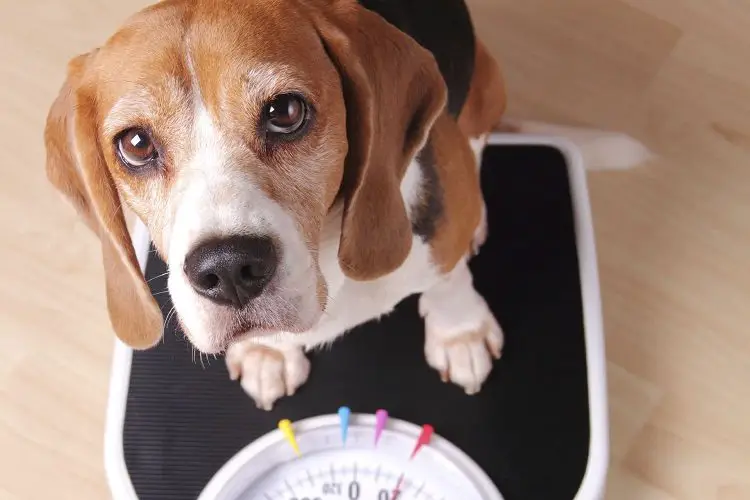Last Updated: 2 years ago
So, your dog is unwell.
He’s been feeling lethargic, is constantly thirsty, and just looks down in the dumps.
Maybe he’s been in a fight and gotten injured. Or it could be that he’s just getting old. But there could be another possibility—maybe your dog has diabetes.
In this article, we examine the issue of diabetes. We’ll consider the signs of diabetes in dogs, the risk factors, and treatment.
Symptoms

The symptoms of dog diabetes are:
- Intense thirst
- Frequent urination
- Constant hunger
- Losing weight
The main reason that dogs with diabetes are constantly thirsty is that glucose builds up in their bloodstream.
This makes the kidneys go into overdrive to flush the excess blood sugar from the body through their urine. Frequent urination causes the dog to dehydrate and increases the desire to drink large amounts of water.
Dogs with diabetes are frequently tired because their bodies is unable to produce the energy that it needs to function properly.
If you notice that your dog is drinking at least half of its bowl of water every time you put it in front of him, urinating for minutes at a time and sleeping most of the day, it is quite likely that he could have developed diabetes mellitus.
What is Canine Diabetes?
Canine diabetes is the dog version of diabetes mellitus. It is a common condition in canines but mainly affects the following breeds:
- Golden Retrievers
- German Shepherds
- Miniature Shaunezers
- Keeshond
- Poodles
However, all breeds of dogs can be affected by diabetes. It occurs more frequently in female dogs, with a ratio of three to one in their favor. Most dogs develop diabetes between the ages of six and nine.
A dog will become diabetic when the islet cells in the pancreas do one of two things:
- Stop producing insulin
- Don’t produce enough insulin
In some cases, pancreatitis may be the cause of the inability of the islet cells to produce insulin. Insulin is a hormone that is used to transport glucose into the cells of the body to be used as a source of energy for the body.
When a dog does not have enough insulin to do this job, it will develop hyperglycemia (high blood sugar) and glucosuria (high urine sugar).
A dog with either of these conditions will be constantly thirsty and frequently urinating. This is because the glucose builds at very high levels in the bloodstream, forcing the kidneys to work overtime to try to expel it all from the body through the dog’s urine.
This constant urination will, in turn, cause the dog to become dehydrated, increasing the urge to drink water. Diabetic dogs are also very tired and hungry. This is because their body is unable to produce the energy that it needs. It will try to get it from food.
Dog Diabetes Complications
Diabetes is sometimes referred to as the ‘mean disease.’ Not only is it difficult to treat (and especilly so in canines), but it can lead to a number of rather unpleasant complications. These may include:
- Ketoacidosis (DKA)
- Cataracts
- Uveitis and Glaucoma
- Diabetic Neuropathy
- Infection
Let us take a closer look at these conditions.
Ketoacidosis
This is a potentially life-threatening condition that can result when the body uses fat rather than glucose as its energy source.
When there is not enough insulin available for the blood sugar in the blood to be transported into the muscle cell to be converted into energy, the body will begin to burn fat as its source of energy. When fat is metabolized for energy it produces a by-product called ketones ( as in the Keto diet).
These ketones normally get excreted through the urine. However, if the urine is not able to excrete the ketones fast enough, they will build up in the body. This can result in a condition known as ketoacidosis.
The kidneys rely on urine to flush both the excess glucose and the ketones out of the body. Yet, as the levels of these increase, the body is forced to produce more and more urine in order to get rid of them.
This results in dehydration and a cycle of distress on the body that requires immediate treatment.
The symptoms of ketoacidosis in dogs are:
- Frequent urination
- Excessive water consumption
- High blood sugar levels
- High levels of ketones in the blood
- Constant fatigue
- Nausea and/or vomiting
- Abdominal pain
- Breathing difficulty
- Acetone odor
- Confusion
- Dehydration
If you suspect that your dog is developing ketoacidosis you should take him to the vet immediately. The best way to prevent this condition is to constantly monitor your dog.
Be attuned to how your dog normally acts so that you can pick up on any abnormalities. You can test your dog for urine sugar at home to catch the condition early on.
You should feed your dog a low carb diet.
Cataracts
Many dogs with diabetes develop cataracts, with quite a few of them going blind within a year. The high levels of blood sugar cause the eye’s lens to become cloudy and opaque.
This can eventually cause blindness. The one bright side of this is that dogs adjust to blindness far more readily than humans do. The quickly heighten the use of their other senses, such as hearing and smell.
Uveitis and Glaucoma
Sometimes a cataract that develops in the eyeball can actually leak protein into the eyeball. This leads to a severe level of inflammation in the eyeball that is known as uveitis.
If you suspect that your dog has any of these eye problems, you should take him immediately to a canine ophthalmologist. If left untreated, the condition can lead to permanent loss of sight.
Diabetic Neuropathy
the high levels of glucose in the bloodstream can lead to nerve damage. While more frequent in diabetic cats, this condition can also occur in dogs. The condition is often mistaken by pet owners as a first sign of old age, when it could well be an indicator of diabetes mellitus.
The parts of the nervous system that is outside of the brain and spinal cord are called peripheral nerves. Neuropathy refers to some sort of dysfunction of the peripheral nervous system. The signs of this condition include:
- Weakness
- Paralysis
- Impaired muscle reflexes
- Reduced muscle tone
- Loss of the pain sensation
The first indication of diabetic neuropathy that a pet owner will usually notice is weakness in the hind part of the animal.
This may cause the dog to frequently stop to rest and have great difficulty climbing stairs. Over time, the weakness will spread to the front legs. Weakness of the muscles around the larynx can also cause a constant wheezing.
Some dog breeds will be prone to developing a condition known as megaesophagus. This is a chronic expansion of the esophagus caused by a loss of normal muscle tone which prevents the dog from swallowing properly.
A dog with this condition will often regurgitate food after eating. Fortunately, the condition is often reversed when blood sugar levels are brought down.
Infection
It is quite common for dogs with diabetes to suffer from constant infections. The high levels of blood sugar in the system of both humans and canines creates an ideal environment for the spread of bacteria.
Often the increasing bacteria actually lead to the development of even more glucose in the system. This creates a vicious cycle.
If you suspect that your dog has an infection, get him directly to a vet. The most common signs of infection in diabetic dogs are skin conditions, urinary tract infections, prostate infections, and pneumonia.
Dog Diabetes Treatment

Diabetes cannot be cured or fixed. It can only be managed. The way to manage diabetes is to introduce insulin to the body to compensate for the body’s inability to produce it.
One of the most difficult things as the owner of a diabetic dog is to figure out the correct dose of insulin to give to the dog. To get this right it is vital that you work closely with your veterinarian.
When humans have diabetes, they must keep their insulin levels within a tight range. This is achieved by testing the blood sugar levels every day and adjusting that level with specific injections of insulin in order to keep the blood sugar within the required range.
However, it is simply impossible to regulate the blood sugar levels in a dog to this extent.
A healthy dog will have a blood sugar level between 68-128 mg/dL. Your vet will test the dog initially to find out what its blood sugar level is.
From this he will determine the appropriate dose of insulin to administer per day and you will do so for several days. Then the vet will test the dogs blood sugar level a second time and make any necessary adjustments to the insulin dosage level.
Hopefully, the dog will respond well to this insulin therapy. In that case, the vet will be able to determine the proper ongoing dosage in order to maintain healthy blood sugar levels within a week or so. From there on, he will only need to test the levels every couple of months.
However, some dogs do not respond very well to insulin treatment. In these cases, the vet will have to make quite a number of adjustments to the dosage, requiring ongoing testing of blood sugar levels in order to get it right.
This can be very frustrating for the vet, the owner and, especially, the dog.
Treating Your Dog with Insulin
Insulin is the universal treatment for diabetes, both in humans and in animals. Insulin is a protein that must be taken by injection.
If it is taken through the mouth, it will be digested into the stomach and prove ineffective. It must be injected into the fat immediately under the skin so that it can be absorbed into the bloodstream.
You should never give your dog insulin before it eats, unless you have been specifically advised to do so by your vet.
You should always give your dog its insulin shot after it has eaten. The reason for this goes back to the reason you are giving your dog the insulin shot – to control its blood sugar levels.
When the dog eats a meal, its blood sugar level will rise. The insulin you inject does the job of transporting the glucose into the muscle cell that the lack of natural insulin production prevents from happening.
If you give your dog insulin before it eats, there will not be any excess blood sugar for the insulin to regulate. Instead, the dog’s normal level of blood sugar will be dangerously lowered, leading to hypoglycemia.
This is when the blood sugar level drops dangerously low. The dog will become very lethargic and may even lapse into a diabetic coma. This is a critical condition, which will require getting the dog to the vet immediately.
Insulin FAQ
Where do I get insulin and what type?
You can buy the insulin for your dog from Walmart. But you need to be careful that you get the right type. You can get either Humulin N or Humulin R.
The one you need is Humulin N. This is an intermediate-acting insulin and has a cloudy milky-white appearance. It takes effect about 1-3 hours after being injected, peaks around 8 hours and lasts 12-16 hours.
Humulin R is a short-acting insulin and is crystal clear in appearance. It takes effect 30-60 minutes after being injected, peaks in 2-4 hours and lasts for 5-8 hours.
The wrong type of insulin will have a negative effect on your dog, causing him to become more dehydrated and to urinate more frequently. So, always be sure to check the label before injecting your dog or giving him any other medication.
What do I need to know but insulin?
Here are some other key facts about insulin that you should know about:
Insulin will not work if it is stored below 36 degrees or above 86 degrees.
Insulin can be damaged by sunlight, so keep it out of direct sunlight.
Be sure to mix the insulin well but do not shake the bottle. If you do shake the bottle this can cause clumping, frosting or micro bubbles, all of which can impair the delivery of the insulin into the bloodstream.
The best way to mix insulin is to gently roll the vial back and forth between your palms, tilting your hands from side to side to move the fluid around the vial. Do this often enough to make sure that the insulin is thoroughly mixed.
How do you inject your dog with insulin?
Treating your dog with insulin shots may seem rather daunting. However, your vet will train you in the proper process for doing this. Here is an overview of the process:
Massage or stroke the dog before the injection to calm and relax him. When you develop this pattern the dog will get to know that the injection will be following and will not be alarmed.
You may wish to reward your dog with a treat during or immediately following the injection. If you put a small treat in front of the injection you may be able to keep him still while you give him the insulin.
Warm the insulin before you inject it. Injecting cold insulin is uncomfortble for both humans and dogs. Warm the insulin only with your hands. Never put insulin the microwave, hot water or anything else! You can warm your hands on the sides of a cup of hot coffee and then place them on the vial of insulin to warm it up.
Fill the syringe with the appropriate dose of insulin then hold the syringe between your fingers for a minute.
To inject, push the syringe firmly and firmly through the skin. The dog will only feel the penetration of the skin. After that, he will feel nothing.
Once the needle is inserted, inject at an even, moderate pace.
There is no need to clean the injection site with alcohol wipes. Rather than disinfecting the skin, alcohol may cause pain to the dog as it wets the fur.
Hold the syringe parallel to the dog’s body when injecting.
Use a new syringe for every injection.
Use a different spot on your dog’s body each time you give it an injection. However, you should inject in the same general area each time. This may be on the side behind the shoulder or hind end. Check with your vet about the best injection sites as this differs between breeds.
If you notice small amounts of insulin leaking out of the injection site, consult your veterinarian.
Pinch and pull your dog’s skin occasionally throughout the day. This will not make him think he is about to be injected every time you touch his skin.
Conclusion
Be on the watch for the tell-tale signs that your dog has diabetes mellitus. Be especially on the look-out for lethary, unquenched thirst and frequent urination.
Get him to the vet quickly if you suspect your dog has diabetes. Then get prepared to inject him daily in order to control his blood sugar levels. Follow our tips above so you can do this confidently and effectively.
Resources:



